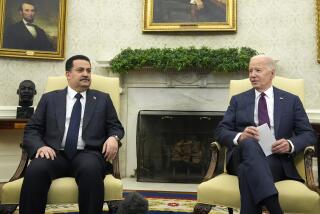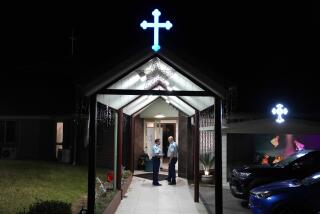Top two Al Qaeda in Iraq leaders are dead, officials say
U.S. and Iraqi forces have killed the top two leaders of Al Qaeda in Iraq and detained a large number of their followers, officials said Monday, in what appears to be a major strike against the persistent extremist group blamed for a string of recent bombings that have destabilized the nation.
Army Gen. Ray T. Odierno, the top U.S. military commander in Iraq, called the deaths “potentially the most significant blow to Al Qaeda in Iraq since the beginning of the insurgency.”
Prime Minister Nouri Maliki, who is fighting to hold on to his post in a new government after last month’s disputed election, appeared on television to trumpet the killings, calling them a triumph for the Iraqi security forces that “broke the back of Al Qaeda.”
The two Al Qaeda in Iraq leaders, Abu Hamza Muhajir and Abu Omar al Baghdadi, were killed Sunday in an Iraqi-led raid supported by U.S. forces on an Al Qaeda hide-out in a remote corner of Anbar province, about 6 miles southwest of Tikrit, officials said. A U.S. soldier was killed in the assault when a helicopter crashed, a U.S. military statement said.
Muhajir, also known as Abu Ayyub al Masri, was an Egyptian who was anointed by Osama bin Laden to head Al Qaeda in Iraq after the 2006 killing of Abu Musab Zarqawi. Trained in Afghanistan, Muhajir was considered a top international Al Qaeda operative whose expertise was behind many of the bloodiest bombings in Baghdad, and who had been hunted by the U.S. since 2004.
Less is known about Abu Omar al Baghdadi, the nom de guerre of the Iraqi who headed the Islamic State of Iraq, an umbrella organization formed by Al Qaeda in 2006 to give the organization a more Iraqi identity. The military gave his real name as Hamid Dawud Mohammed Khalil al Zawi, although officials had said earlier that they believed Al Baghdadi was a fictional character.
A U.S. intelligence official said the deaths did not mean Al Qaeda in Iraq would fall apart, noting that it survived the killing of Zarqawi, its founder, in a U.S. airstrike in 2006. The latest killings “were a setback to the organization, but other people will most likely step up,” the official said.
Much will depend on whether Al Qaeda in Iraq is able to regroup, and how quickly. After Zarqawi’s killing, the group quickly revived under Muhajir, striking even more forcefully with a series of car bombs in Baghdad that helped sustain the sectarian violence raging at the time.
Iraq has changed much since then; most Sunnis have turned their backs on extremism and joined the political process. Iraq’s security forces, now numbering at least 700,000, are far stronger. The remote location of the hide-out, deep in the desert and across a large lake from the nearest town, suggests that Al Qaeda in Iraq operatives can no longer find refuge in populated areas.
The larger Al Qaeda network also has shifted its attention from Iraq to Afghanistan and Pakistan, as U.S. troops build up in that region. It is unclear whether the organization would be prepared to assign a top leader to Iraq at this stage, said Brett McGurk, a fellow at the Council on Foreign Relations and the lead negotiator for the security agreement between Iraq and the U.S.
“In Iraq we never know the strategic impact for a couple of months out,” McGurk said. “Is there an al Masri deputy waiting in the wings?”
A U.S. military official in Washington said Muhajir and Al Baghdadi were killed in a joint operation by Iraqi and U.S. special operations troops. The team began taking fire as it closed in on the site where the two militants were believed to be hiding, the official said.
The troops then called in supporting fire, either from artillery units or an Apache attack helicopter, the official said. It was this strike that is believed to have killed the two militants, the official said.
Al Baghdadi’s son and Muhajir’s assistant were also killed, and 16 associates were captured, the military said. Maliki said the raid near Tikrit, the birthplace of the late dictator Saddam Hussein, had netted almost the entire Al Qaeda leadership between the northern province of Nineveh and Baghdad, and had also turned up large quantities of intelligence on the group’s remaining networks and cells, including direct communications with bin Laden and details of a plan to bomb Baghdad churches in the coming days.
Though Al Qaeda no longer controls territory anywhere in Iraq, it has adapted by focusing its attention on bombings that grab headlines by causing maximum casualties. U.S. officials say it operates a secretive system in which individual cells are unaware of others’ activities. Officials fear there could be many groups still ready to carry out attacks.
U.S. officials believe the group was behind the devastating bombings that have claimed hundreds of lives in Baghdad since August. The bombings have jeopardized the security gains made since the U.S. troop buildup in 2007 and threatened to reignite sectarian warfare when Iraqis are engaged in delicate and fractious negotiations over forming a new coalition government after last month’s elections.
Odierno is scheduled in early May to give an assessment of whether it is safe to send home all U.S. combat troops, bringing the force numbers down to 50,000 by the end of August, as planned by the Obama administration. Privately, U.S. officials have said that no amount of violence would persuade the White House to change the plan, and the killings of the two Al Qaeda in Iraq leaders will help lift some of the anxiety surrounding a withdrawal that coincides with a fraught political period in Iraq.
The Iraqi government has on numerous occasions claimed to have captured Al Baghdadi, and last year televised the confession of a man said to be Al Baghdadi, to widespread skepticism. U.S. officials said privately that they were doubtful and some Iraqi officials said the real Al Baghdadi was a man with the same name as that given by the U.S. military.
Maliki appeared to acknowledge that the man paraded on television was not the real Al Baghdadi.
“We discovered previously that Al Qaeda attempted to make a diversion operation, to create more than one Abu Omar al Baghdadi,” Maliki said, “but the one found today is the original Abu Omar Baghdadi.”
Times staff writers Julian E. Barnes and David S. Cloud in Washington and Caesar Ahmed in Baghdad contributed to this report.
More to Read
Start your day right
Sign up for Essential California for news, features and recommendations from the L.A. Times and beyond in your inbox six days a week.
You may occasionally receive promotional content from the Los Angeles Times.






